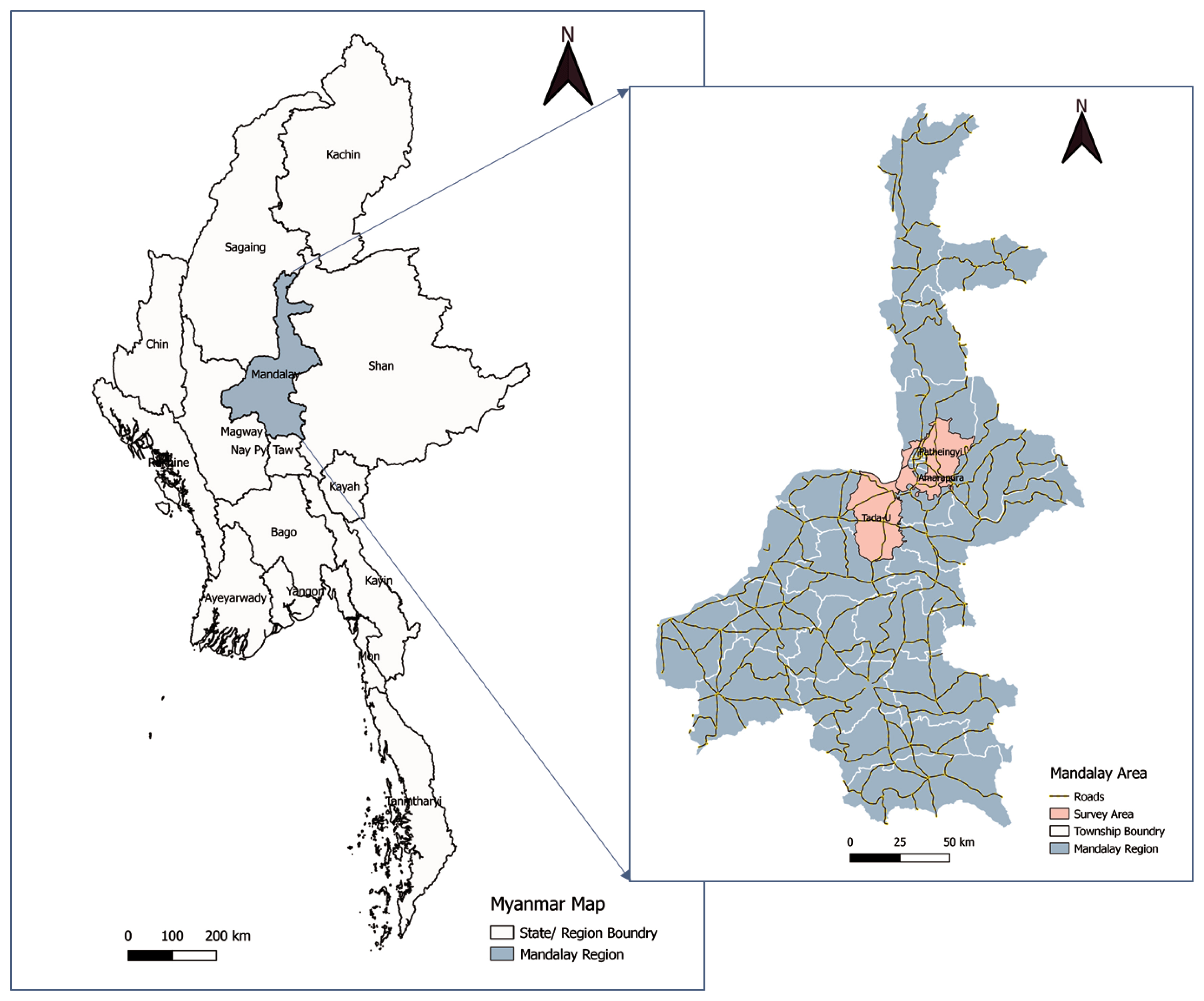 |
 |
| Anim Biosci > Volume 37(3); 2024 > Article |
|
Abstract
Objective
Methods
Results
Conclusion
Notes
CONFLICT OF INTEREST
We certify that there is no conflict of interest with any financial organization regarding the material discussed in the manuscript.
FUNDING
The authors are grateful for the support of Obihiro University of Agriculture and Veterinary Medicine (OUAVM), Japan, and Livestock Breeding and Veterinary Department (LBVD), Myanmar, especially for the project titled ŌĆ£Economics-epidemiology integrated study on neglected zoonotic diseases: behavior embedded in society and countermeasures for externalityŌĆØ funded by the JSPS KAKENHI Grant Number JP 18KK0184 (herein after ŌĆ£KAKEN Myanmar ProjectŌĆØ).
Table┬Ā1
| Variables | Definition | Total farms (n = 92) | Žć2 (df = 1) | p-value | ||
|---|---|---|---|---|---|---|
|
|
||||||
| Migratory farm (n = 54) | Dairy farm (n = 38) | |||||
| FarmersŌĆÖ characteristics | ||||||
| ŌĆāFarmer age (AGE)1) | FarmerŌĆÖs average age in years | 44 | 40 | 49 | 47.18 | 0.12 |
| ŌĆāEducation (EDU)1) | 1: Primary; 0: Other level | 53.3% | 53.7% | 52.6% | 0.01 | 0.92 |
| ŌĆāExperience (EXP)1) | Average years working in livestock farming | 17.5 | 15 | 20 | 34.15 | 0.20 |
| ŌĆāCommon grazing (GRAZING)1) | 1: cattle grazing in common pasture; 0:no grazing | 46.8% | 46.7% | 1.1% | 50.60 | <0.01*** |
| ŌĆāMigration (MIGRATE)1) | 1: Migratory; 0: Not migratory | 58.7% | 100% | 0% | 92 | <0.01*** |
| Farm characteristics | ||||||
| ŌĆāCattle herd size (CATTLE)1) | Average cattle heads in farm | 19 | 28 | 11 | 61.89 | 0.01** |
| ŌĆāFeeding system | 1: Forage; 0: Concentrate | 38.0% | 62.9% | 2.6% | 34.4 | <0.01*** |
| ŌĆāRaising system (RAISE)1) | 1: Extensive; 0: Intensive | 52.2% | 88.9% | 0% | 70.63 | <0.01*** |
| ŌĆāTraining (VET TRAIN)1) | 1: Attend animal husbandry veterinary training; 0: Other or no training | 1.1% | 0% | 2.6% | 1.44 | 0.23 |
| ŌĆāBrucella sero-positivity at farm level (BRUCELLA)1) | 1: Positive; 0: Negative | 9.8% | 14.8% | 2.6% | 3.75 | 0.05* |
| ŌĆāAbortion case (ABORTION) | Average abortion case in cows in past 1 year | 7.6% | 7.6% | 0% | 5.33 | 0.02** |
1) Bold text in brackets indicates the variable used in the Probit model (Table 3).
Table┬Ā2
| Variables | Total farms (n = 92) | p-value | ||
|---|---|---|---|---|
|
|
||||
| Migratory farm (n = 54) | Dairy farm (n = 38) | |||
| Knowledge (K) | ||||
| ŌĆāKnow brucellosis disease1) (KNOW)2) | 18 (19.6%) | 10 (18.5%) | 8 (21.1%) | 0.76 |
| ŌĆāReduced milk production (True) | 4 (4.34%) | 1 (1.9%) | 3 (7.9%) | 0.07* |
| ŌĆāAbortion of cow (True) | 4 (4.34%) | 1 (1.9%) | 3 (7.9%) | 0.16 |
| ŌĆāSwelling of joints (arthritis) (True) | 1 (1.9%) | 1 (1.9%) | 0 (0.0%) | 0.39 |
| ŌĆāThe cow will be blind (False) | 2 (2.2%) | 2 (3.7%) | 0 (0.0%) | 0.39 |
| ŌĆāBlisters in the mouth (False) | 1 (1.9%) | 1 (1.9%) | 0 (0.0%) | 0.39 |
| ŌĆāTransmission from cow to cow (True) | 2 (2.2%) | 1 (1.9%) | 1 (2.6%) | 0.36 |
| ŌĆāTransmission from cow to human (True) | 3 (3.3%) | 1 (1.9%) | 1 (2.6%) | 0.36 |
| ŌĆāAverage | 2.8% | 2.6% | 3.0% | 0.37 |
| Attitude (A) | ||||
| ŌĆāCows that had aborted should not be sold to other farms | 21 (22.8%) | 10 (18.5%) | 11 (28.9%) | 0.24 |
| ŌĆāCollect new information about cattle diseases | 47 (51.1%) | 21 (38.9%) | 26 (68.4%) | 0.01*** |
| ŌĆāParticipate in training about cattle diseases | 18 (19.6%) | 6 (11.1%) | 12 (31.6%) | 0.02*** |
| ŌĆāReport the aborted case to a veterinarian | 75 (81.5%) | 38 (70.9%) | 37 (97.4%) | <0.01*** |
| ŌĆāEating cow placental debris (EAT)2) | 10 (10.9%) | 2 (3.7%) | 8 (21.1%) | 0.01*** |
| ŌĆāAverage | 39.1% | 28.6% | 49.5% | 0.04*** |
| Practice (P) | ||||
| ŌĆāSelf-removal of placental debris by bare hand (Yes) (HAND)2) | 60 (65.2%) | 42 (77.8%) | 18 (47.4%) | <0.01*** |
| ŌĆāSeparate diseased animals from others (Yes) (SEPARATE)2) | 46 (51.1%) | 23 (42.6%) | 23 (60.5%) | 0.09** |
| ŌĆāSeparate animals that have aborted from others (Yes) | 39 (42.4%) | 19 (35.2%) | 20 (52.6%) | 0.10* |
| ŌĆāSell milk from cows that have aborted (Yes) | 22 (23.9%) | 0 (0.0%) | 22 (57.9%) | <0.01*** |
| ŌĆāConsume milk from cows that have aborted (Yes) | 17 (19.4%) | 0 (0.0%) | 16 (42.1%) | <0.01*** |
| ŌĆāAverage | 41.6% | 31.1% | 52.1% | 0.25 |
1) Following questions estimate the knowledge of Brucellosis if farmers answer ŌĆ£KnownŌĆØ or ŌĆ£Have heardŌĆØ about Brucellosis. In parentheses ŌĆ£TrueŌĆØ is the correct answer and ŌĆ£FalseŌĆØ is the incorrect answer.
2) Bold text in parentheses represents the variables used in the Probit model (Table 3).
Table┬Ā3
REFERENCES
- TOOLS








 PDF Links
PDF Links PubReader
PubReader ePub Link
ePub Link Full text via DOI
Full text via DOI Full text via PMC
Full text via PMC Download Citation
Download Citation Print
Print





